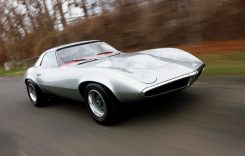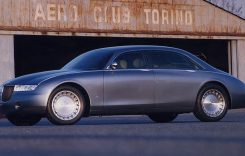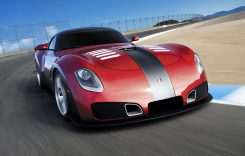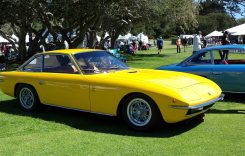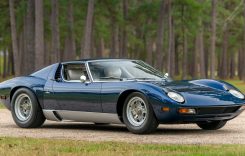Contrary to the tried-and-true motorcycle design formula conceived by other Japanese brands, Yamaha forges a new path with its unorthodox 2012 Yamaha YZ450F ($8350). The Tuning Fork’s 450cc dirt bike employs different technology to build a more competitive race bike.

Like the Suzuki, the blue bike can be a little tricky to get the engine lit demanding one well-timed kick to the kick start lever. It’s one of two bikes that could most benefit from electric start. Right off the bottom the Yamaha delivers a strong rush of power comparable to the Kawasaki. However, torque feels a tad more metered, making it easier to escape corners without excessive wheelspin.
“I really like the power delivery on the Yamaha,” says intermediate-level tester, Frankie Garcia. “It’s always there when you want it. It doesn’t get all squirrely when you’re on the gas and it doesn’t want to wheelie everywhere.”
“Motor wise it is absolutely competitive,” confirms Taylor. “It’s not any better than the other bikes but it’s definitely fast. Good hit off the bottom and the mid-range is good too but it falls flat on top. If you ride it in the powerband its fast though.”
(Above) The Yamaha YZ450F is easy to ride but it takes some time to get used to its unique handling. (Center) The Yamaha YZ450F features some of the best stock suspension on the market. (Bottom) The Yamaha’s ergonomics are a little bit awkward for larger riders.
But not all of our testers agreed: “On mid-to-top that thing [engine] got going,” says Simon. “But on the bottom it made a lot of noise and sounded like it was going, but I didn’t feel like it pulled as hard as some of the other ones.”
Looking at the dyno chart proves that all of our testers opinions were accurate. From just off idle power comes on soft but ramps up quickly as revs increase and it transitions into the mid-range enroute to its 27.6 lb-ft peak torque figure at 7300 rpm (fifth best). Although it doesn’t have the monster top-end of the KX, it’s still unleashing 43.16 ponies at 8900 revs (third best) with the power curve flattening nicely, similar to the Honda and 350 SX-F. In the sound test the YZ450F registered a respectable 92.6 dB giving it credit as third quietest. It certainly doesn’t feel that way at the controls however, with a loud, ear-pleasing growl resonating from inside the forward-mounted sportbike-style airbox.
Without any gas in its 1.6-gallon underseat fuel cell the YZ tipped the scales at 241 pounds tying the Kawasaki for third lightest. For reference that’s a full nine pounds heavier than the class-leading CRF450R and four pounds more than the middleweight KTM. In the acceleration tests, the Yamaha sped into Turn 1 in a time 4.8 seconds at 51.3 mph. That placed it toward the back of the field, though it’s only 0.55 second off the red bike. Surprisingly, even with all that mid-range motor performance the Yamaha accelerated faster than all but the 350 KTM (2.8 seconds) in the third-gear roll-on test.
Its drivetrain including five-speed transmission and cable-actuated clutch performed adequately, but it was hard to find neutral at a stop and some riders claim they had to shift more often due to its shorter powerband. This is the reason why it received such a low score in the Drivetrain category.
The Yamaha’s suspension components rated well amongst our testing audience tying the 350 SX-F as runner-up to Honda’s refined set-up. Part of the reason why it didn’t rate higher was the fork and shock didn’t feel quite as plush as we remembered. Both ends of the bike are well-balanced and the YZ was generally pretty undemanding to ride.
Although we all like the Yamaha’s suspension set-up test riders weren’t that impressed with its overall handling. The biggest complaint revolves around the way it steers: “The suspension has always worked well on the Yamaha,” says Garcia. “You come down fast rough braking bump sections and it feels like your riding on the freeway. But as soon as you get in the corner and try and stick it in, the front wants to push… it has some tracking issues.”
“Sometimes it doesn’t want to complete the corners like the other bikes do. It just doesn’t feel like it has the front end traction,” recalls Milan. “I always thought that was me not being forward enough—maybe a body position thing—unfortunately, I learned it was the bike after riding all the bikes back-to-back.”
(Above) The Yamaha YZ450F is one of the more affordable bikes in this test. (Center) The Yamaha hooks up well off the corners as pro-level test rider Matt Armstrong demonstrates. (Bottom) Pro-level test rider Drake McElroy airs it out on the Yamaha at Zaca Station. For the most part, the Yamaha is very easy to ride but takes some time to get used to its unique handling.
Part of its handling woes may be attributed to its awkward ergonomics. Not only is it the widest-feeling machine it has a low-feeling stance. The ergos aren’t as well-proportioned either, making it difficult for larger riders to get comfortable at the controls. Explains Taylor: “It is a very big bike and it takes a lot of getting use to for me. The front end feels real light because I can’t get my body forward enough because the radiator shrouds and airbox are so fat.”
In Super Lap, Simon struggled, logging his fifth slowest lap time of 1’45.35. See, who raced Yamaha’s last season, reported he was more comfortable, lapping Zaca Station in a time of 1’47.0 which was his second-fastest time behind the Suzuki. The average of their two lap times positioned the Yamaha fourth-fastest overall.
None of our testers were really blown away with the way the Yamaha’s brakes performed. While they offer adequate stopping power they weren’t quite as sharp feeling as the brakes on the European bikes, or the Honda or Suzuki for that matter, and rated lower than all but the Kawi.
Mid-pack scores in many of our test rider’s notepads along with its curious handling and funky ergonomics relegated the YZ into a tie for fifth-place. The Yamaha is a fun, fast, and stone-ax reliable bike to race but it requires such a specific riding style that many of our testers never really meshed with it. If Yamaha could make small tweaks to the way the rider interacts on the bike and steering predictability it could have a vastly more competitive platform next year.
